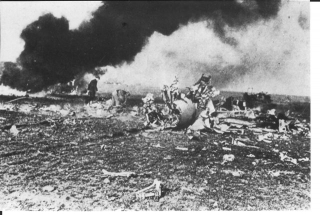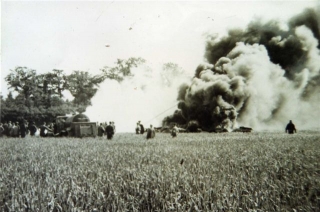Mission No. 92 – 12th December 1944 – Darmstadt
The following account by Lt John E DeWitt was published in the 493rd BG Association magazine "Briefing Notes"
Take off at daybreak all routine – flying in ‘B’ group – when passing over the English Channel , an exhaust ‘stack’ on the left outboard engine ‘blew’. Lt. John Dewitt – pilot- decided to return to base before the situation deteriorated. The damaged engine burst into flames as they approached the base – due to low cloud they were already below a safe height to bale out and still carrying a full load – there were no alternatives. They had to land before the engine fire spread. As they made the final turn “ I saw the burning wing sag”. At this moment Lt. David Moore in the control tower announced over the tannoy “to all personnel – take cover”. Devils Own clipped the tops of the trees, the burning engine dropped out of the wing, straight ahead was a parked B17, the flight control black and white control caravan and a trailer full of ground crews. With considerable skill and landing on mud, with wheels up, the B17 hit the ground at 40mph. Four crew in the rear were ordered to jump from their escape hatch, the engineer, Navigator and Bombardier catapulted themselves out between the fuselage and the left inboard engine. The co-pilot went out of his window and I went after him off the right wing – running like hell. I was less than 500ft away when there was a terrific explosion. All the windows of the control tower were blown out, causing slight injuries and cuts. A section of the landing gear was blown over the control tower and was burning between two jeeps. The force of the explosion was so great, it lifted the metal doors off the nearby hangar.
To quote Lt. Dewitt’s own account “The Good Lord was riding command pilot to-day”.
The destruction of ‘Devils Own’ was complete – not a single life had been lost but parts of the aircraft still surface on the site of the wreck at Debach Airfield. More original photographs can be seen in the gallery.
“Cock of the Sky”
Death on a June morning in 1944
14th June 1944, mission no.6, eight days after the D-Day landings. Targets – German held airfields in France. Take off begins at 03.00 hrs and after a successful mission, aircraft begin to return to Base around 09.00 hrs. B24 Liberator No.41-29569 named “Cock of the Sky” allowed other aircraft to land first. With one engine out of action and significant flak damage. On their final approach to the runway at Debach, the ground controller realised that they were too high to make a successful landing and they were told to overshoot and approach again. They were heading towards Melton at about 1,000ft when it all went wrong. When they turned in the circuit pattern, the wing holding the dead engine stalled and the aircraft went into a spin and hit the ground. The crash as reported by the local police at 09.15 hrs – the machine was seen to bank sharply and roll on it’s back – crashing just behind St. Audry’s Hospital in the grounds of Foxborrow Hall. Petrol exploded and the machine disintegrated. The Fire Service from Woodbridge promptly attended followed by USAF personnel from Debach. The crash damaged only an acre of growing crops, farmed by Mr F. Smith of Woodbridge. Ten young men died that morning. They had only arrived at Debach a few weeks before. We that are left will remember, always.
Air Sea Rescue
“Mizry Merchant” ditched in the North Sea on 20th July 1944. The target of the day was Russelsheim-Mainz, Germany.
From the Mission Report:-
Aircraft 41-29561 turned back early when it lost an engine at the I.P. (causes unknown), jettisoned its bombs and later ditched in the channel. (From the report by Don Mackintosh, skipper of RML512 it appears that Mizry Merchant suffered a “massive loss of fuel, possibly through enemy action”)
The crew were recovered by Rescue Motor Launch No 512, unfortunately the bombardier, Carl McClendon, did not survive.
Following are two accounts of the rescue of the crew.
The first by Don Mackintosh, skipper of Air-Sea Rescue launch RML 512, and the second by engine room “stoker” Arthur Hickingbottom.
The Rescue of a B-24 Crew After Ditching in the North Sea
-----
By Don Mackintosh
-----
The time was Summer 1944 -- I cannot give a more precise date -- when I was on patrol one day in RML (Rescue Motor Launch) 512, thirty miles off England's East Anglian coast. Early in the morning, we had watched a large formation of B-24 Liberator bombers flying a few miles south of our position on a north-easterly course towards their German target. Some time later, P-38 Lightning and P-47 Thunderbolt fighters, in pairs, came speeding along the same flight path, to rendezvous with the bomber force over enemy territory, and provide a defence against German fighter aircraft. For the next three or four hours, we would have little to do but wait, while keeping a constant radio watch to pick up any distress ("Mayday") calls from the strike force, and ever, with guns manned, prepared to defend ourselves against a sneak attack from a marauding enemy aircraft.
Around noon, the first "Mayday" calls came over the radio - far away, faint and confused. Gradually they died away. We never found out why. Many possibilities went through our minds, some we preferred not to dwell on. However, on this occasion, there was one call that persisted, and grew stronger and clearer. Control headquarters ashore responded with course instructions that would take the casualty to a track where rescue craft would be most able to respond quickly should it have to ditch. Alternatively, the plane might remain airborne long enough for it to be guided to a friendly airfield. We could only await developments, and make our preparations should we be called into action.
Still the "Mayday" calls kept coming, and increased in strength all the time.
Meantime the main bomber force passed us, three or four miles to the east on a south-westerly course, heading for a landfall on the Suffolk coast. If the plane in trouble followed the same flight path, it too would pass through our sector -- if it got that far. I decided that this was the most likely of the pilot's options, although our sector covered about a thousand square miles, and he could enter it at any point and come nowhere near us. I decided to play my hunch and close the gap between our patrol station and the presumed flight path. The "Mayday" call was by this time almost overpowering over the radio. The plane must be very close. It was. I had only been on the move for a few minutes when a lookout shouted "Aircraft Red Four Five. Low!". That meant that there was an aircraft low in the sky forty five degrees off the port (left hand) bow. There, to the north-east and clearly visible to the naked eye, were three specks against the sky, low over the water. Through binoculars these showed up as a B-24 Liberator, with a P-47 Thunderbolt on either side as escort. Nearer still, and it could be seen that the Liberator had no power on the engines, and that the plane was on a long low glide. It was simply the speed of the descent that enabled the pilot to keep his plane airborne for long enough to be able to make a successful touchdown on the water.
His, and his aircraft's, ordeal ended when, after skimming the wave tops for a short distance, the plane eventually hit the water on an even keel, sending up a great wave of spray which completely hid it.
We were, by then, a little more than a mile away, and the plane had ditched right ahead of us. In the seconds it took the disturbed water to subside, the plane had disappeared, and in its place were men floating among the waves. Two men were clinging to a wheel, but there was no other wreckage. The plane's dinghy, which should have surfaced, had not done so. But for our being on the spot and able to take the survivors on board, they would have had to wait for a rescue boat to reach them, and shock and hypothermia would almost certainly have taken lives. It is a tribute to the Air-Sea Rescue control ashore for their deployment of the rescue boats along the bombers' flight path, and the skill and courage of the Liberator pilot and crew in keeping airborne for long enough for us to be able to reach them so quickly.
However, there was one casualty. Before we radioed details of the rescue to base, I took a last look at the apparently untroubled sea, and I saw, almost alongside, the body of an airman floating upright just beneath the surface. Our crew got a line around him and hauled him aboard, where our paramedic spent a long time trying resuscitation, but it was hopeless.
Quick though the rescue had been, this casualty must have been under water for all of fifteen minutes. Meantime, the fighter escorts were circling the area where the Liberator had gone down, but when we arrived on the scene one of them flew off to continue its patrol. The other followed after I had given details of the pick-up over the R/T. After I had passed the same information by radio to our own base, together with our estimated time of return, I had a chance to make personal contact with the survivors, now sitting in the officers' cabin - wardroom. Off-watch members of my crew had helped them to dry off after they had shed their soaked flying gear, and had provided them with survivors' clothing that we carried, comprising sailors' navy-blue trousers, thick white roll-neck jerseys, and footwear. Not elegant, but warm and dry. They had also been given hot drinks, and, if they wanted it, a tot of rum. The men were very subdued as they came to realise that they were now safe after having suffered a nightmare ordeal. However I learned from the pilot, their skipper, that they had had a massive loss of fuel, probably caused by damage to the supply system through enemy action. I told him how sorry we were at the loss of one of his crew.
The man had evidently stayed at his action station, instead of joining the rest of the crew in the position prescribed for minimising fatalities and injuries, and had probably been either killed or knocked unconscious by the impact when the plane struck the water. Dead or unconscious, he had gone down with the plane.
When we reached our base, transport and an ambulance from the USAAF were waiting on the quayside. Stretcher-bearers came aboard to take the dead airman away, and the survivors collected their flying gear and went ashore.
We hoisted our White Ensign, which had been flown at half-mast as a salute to the dead, and we got ready for our next patrol.
(Reproduced with kind permission of John Mackintosh, Brother of Don.)
A picture for you to use if you wish to, it was taken on Xmas day 1944. The crew of H.M.R.M.L 512 plus a few guests .I am on the end of the back row on the left side of the picture. During the rescue of the crew of Mizry Merchant our Coxswain pictured on front row fourth along on the right side of the picture, personally rescued an airman by jumping overboard and swimming out to him with a line. He was clinging on to wreckage which was the nose wheel but was not going to float for much longer, Cox managed to get a line round him and got him back to the ship. I was on duty in the engine room and had only a limited view through the portholes. We returned to base sadly carrying the body of the airman who was killed on impact plus 9 other survivors. Another piece of information you might be interested in, we were called up on (the) recently installed VHF radio by a P47 thunderbolt fighter being used on A S R searching, he guided us to the crash scene which was 11 miles away and at a max speed of 22 knots it took us nearly 20 minutes to arrive. Our two 750 hp Hall-Scott engines were busting a gut!
Best wishes Arthur Hickingbottom.





